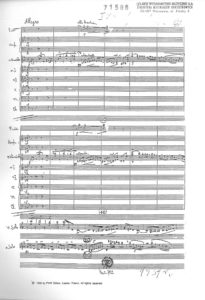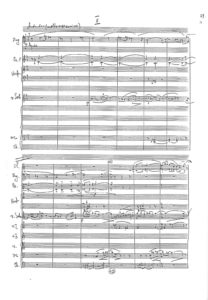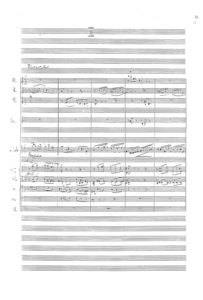- Violin Concerto no. 1, facsimile score PWM, mov. 1
- Violin Concerto no. 1, facsimile score PWM, mov. 2
- Violin Concerto no. 1, facsimile score PWM, mov. 3
Violin Concerto No. 1 was written in 1937, when the composer’s was the concert master of the Polish Radio Orchestra, a position she held for two and a half years. The work was premiered on 28 March 1938 in a performance featuring the composer as the soloist and “her” orchestra, conducted by the ensemble’s Artistic Director, Grzegorz Fitelberg. Announcing the event, the press stressed that the audience would hear “the first work of this kind in the world musical literature written by a woman.” After the premiere the concerto had to wait as long as 61 years to be rediscovered – it was not performed again until 5 February 1999, the 90th anniversary of the composer’s birth, during “Grażyna Bacewicz Days” organised by the Polish Radio and Polish Television. Krzysztof Bąkowski was accompanied by the Polish Radio Orchestra conducted by Jacek Rogala. The same artists subsequently recorded the concerto. Another recording was released by Chandos in 2009, on the centenary of the composer’s birth – the violinist Joanna Kurkowicz was accompanied by the Polish Radio Orchestra conducted by Łukasz Borowicz.
Such a long absence of the Concerto from concert halls was caused to some extent by the composer’s aversion to her early pieces. But – as Tadeusz A. Zieliński wrote already in 1975 – it is a “piece certainly worth being dusted off and presented to today’s audience” (T. A. Zieliński, Spotkania z muzyką współczesną, Kraków 1975, p. 8).
The Concerto has the classic structure of a three-movement piece, preserving the dramaturgy as befits the form (significantly, there are no solo cadenzas!). The “classical” orchestra (Fl., Ob., 2 Cl., 2 Fg., 2 Cor., 2 Tr., Trb., Harp., Archi, Xil., Piatti, Tmp.), holding a discreet dialogue with the solo instrument, makes the instrumentation “openwork” in nature, although the Concerto does not lack moments with stronger sound colours and fragments with a highlighted role of the wind instruments.
The first movement (Allegro) begins with a complex introduction of the solo violin, initially with a regular structure of two A-A1 sentences, signalled at the beginning by orchestral chords. This regularity gives way to a quasi-improvised narrative of the solo instrument, which after some time enters into a dialogue with the orchestra. The introduction announces both the transformations to come and the lively first theme. The motivic integration method appears here as one of the major characteristics of the composer’s style, present in many of her works. With their shape, outline of their motifs, type of progression and uniqueness of sound energy, both the introduction and the first theme resemble forms characteristic of classicism. Yet these quasi-classical sound figures, constantly reshaped by suitable harmonic devices, create a new sound reality with the intensity of artistic expression almost equal to that of the period in question. The melodious second theme (cantabile) provides a natural contrast to the “roguish” first theme. In the development the composer juggles motifs from the introduction and both themes, presenting them sometimes as quasi-imitations with narrative lightness characteristic of early classical works. The whole closes with the initial figure of the introduction, this time not ending with a fermata, as at the beginning, but with a motif suggesting the key of A major, which constitutes the “fabric” of the entire movement.
The fabric of the second movement (Andante, molto espressivo) is a quasi-folk theme appearing in the solo violin and resembling somewhat the initial theme from Karol Szymanowski’s Violin Concerto No. 2. Throughout this movement the composer uses selected motifs of the theme, transforming the wistful melody of the violin into an emotional dialogue with the string group and at some point quite demonic sounding wind group, encompassing high notes of the flute and low notes of the bassoon, supported by short harp glissandos and cymbal interventions. Other interesting expressive solutions include the use of rubato, changes of metre, undulating dynamics and articulation variety. The instruments of the orchestra, treated as solo instruments, create an exceptionally transparent and colourful texture.
The third movement (Vivace) is marked by a return of a jolly mood, while the nature of the main theme, formed out of short, lively motifs, pendular figures and small passages which the composer constantly “juggles”, creates a mood of light-hearted play. The movement, which is a kind of short rondo, also has different episodes: the first (cantabile) is played first by the violin and then repeated in a fragment by the flute; the second, appearing twice as well, amusingly interrupts the narrative with a radical change of the main metre from 6/8 to 2/4. The whole ends with a reminder of the initial motifs of the refrain.
After the premiere of the work the Czas magazine published a review by an anonymous author. As we can read in it,
The “Violin Concerto” by G.B. is characterised by an atmosphere of considerable restraint and matter-of-factness. It is dominated by intellect rich in profound knowledge. At the same time, G. Bacewicz’s new work testifies to her marked progress in musical expression and instrumentation technique, which this highly talented composer and violinist uses with great ease. The piece should be regarded in all respects as a valuable addition to our violin literature.


